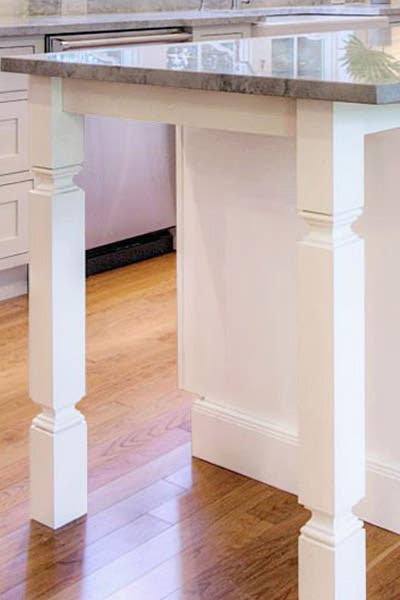Check Out Modern and Standard Designs in Legs For Kitchen Island Jobs
Check Out Modern and Standard Designs in Legs For Kitchen Island Jobs
Blog Article
A Guide to Selecting the Perfect Legs For Kitchen Island for Your Home
Selecting the optimal legs for your kitchen island is a nuanced choice that impacts both the capability and visual charm of this main room. As you consider these aspects, it ends up being noticeable that the ideal legs can change not just the appearance of your cooking area yet additionally its usability for years to come.

Recognizing Cooking Area Island Legs
When picking legs for a kitchen area island, it's essential to comprehend their practical and aesthetic functions in the general design. The legs function as an important support group, guaranteeing stability and resilience for the island, which often functions as a work area, eating location, or gathering area. Consequently, the selection of material and building method need to be robust enough to withstand day-to-day usage and possible wear.
In addition to their structural obligations, legs contribute dramatically to the island's visual appeal. They can boost the kitchen area's design, whether with typical, modern, or diverse styles. The elevation and percentage of the legs are also critical factors to consider; they have to harmonize with the island's kitchen counter elevation while ensuring comfortable seating for those making use of the room.
Furthermore, the leg style can affect the total flow of the kitchen. Open, airy leg styles can develop a sense of lightness, while solid, significant legs might communicate an extra grounded and secure aesthetic - Legs For Kitchen Island. Comprehending these aesthetic and useful aspects will certainly guide house owners in making notified choices that match their cooking area's design and improve its functionality
Popular Styles and Products
The choice of legs for a cooking area island encompasses a variety of preferred styles and products, each offering special features that can improve both performance and aesthetics. Typical legs usually display elaborate details and workmanship, improving classic kitchen layouts.

Elevation and Stability Considerations

The legs of the cooking area island must offer adequate support, ensuring that the structure can hold up against daily usage without changing or tottering. Material choice plays a significant function in security; metal legs, for circumstances, often tend to use higher toughness contrasted to wood.
Matching Your Cooking Area Visual
Picking the appropriate legs for your kitchen area island goes beyond performance; it also plays a substantial duty in the total aesthetic of the space (Legs For Kitchen Island). When official statement selecting legs, consider the layout style of your cooking area.
Legs that match or comparison with your island's surface and bordering cabinets can develop visual consistency or striking focal points. Furthermore, take into consideration the coating of the legs; matte, shiny, or distinctive finishes can substantially affect the overall feeling of the kitchen.
Setup and Maintenance Tips
Mounting kitchen island legs needs mindful focus to detail to make sure both security and visual appeal. Begin by picking a suitable place for your island, guaranteeing it is degree and has ample space for movement. If you are attaching the legs to a wall surface or making use of braces for included assistance, make use of a stud finder to locate wall surface studs. Mark the placement of the legs properly before exploration.
When safeguarding the legs, use high-grade screws and, if needed, timber glue for extra strength. For steel legs, ensure that you are using appropriate anchors and tools to prevent damages to your floor covering. It is a good idea to look for levelness after setup, making changes as required to stay clear of tottering.
Upkeep is equally essential for important site longevity - Legs For Kitchen Island. Frequently examine the legs for any indications of wear or helping to loosen, particularly in high-traffic locations. Clean the legs with a suitable cleaner, avoiding rough products that might scrape the surface area. For wooden legs, take into consideration using a wood conditioner periodically to keep their coating. By complying with these installation and maintenance tips, you can guarantee that your cooking area island legs remain both aesthetically attractive and useful.
Final Thought
In conclusion, choosing the appropriate legs for a cooking area island necessitates cautious consideration of elevation, security, and aesthetic compatibility. Ultimately, thoughtful leg selection plays a critical function in raising both the functionality and style of the kitchen area room.
When choosing legs for a kitchen island, it's important to recognize their visual and practical duties in the overall layout. Open, ventilated leg designs can produce a sense of agility, while strong, considerable legs might communicate an extra based and secure visual. The legs of the cooking area island ought to offer sufficient assistance, making sure that the framework can stand up to day-to-day usage without moving or wobbling.Setting up cooking area island legs needs cautious interest to information to ensure both stability and aesthetic appeal.In final thought, selecting the ideal legs for a kitchen area island requires careful consideration of height, stability, and visual compatibility.
Report this page